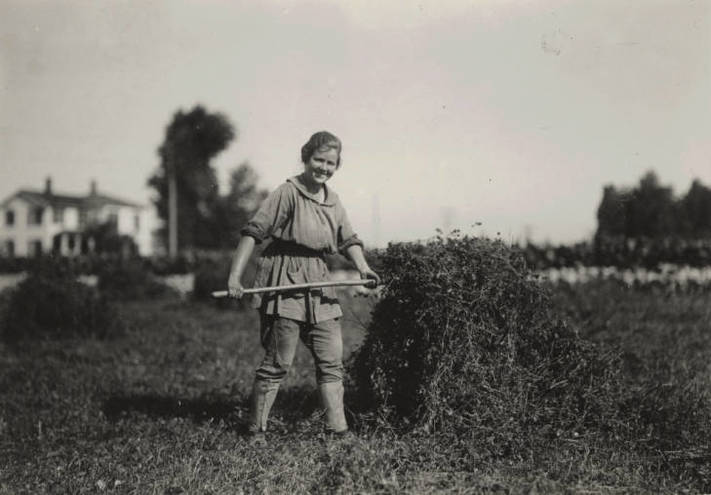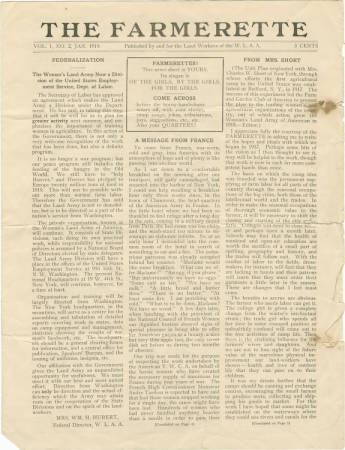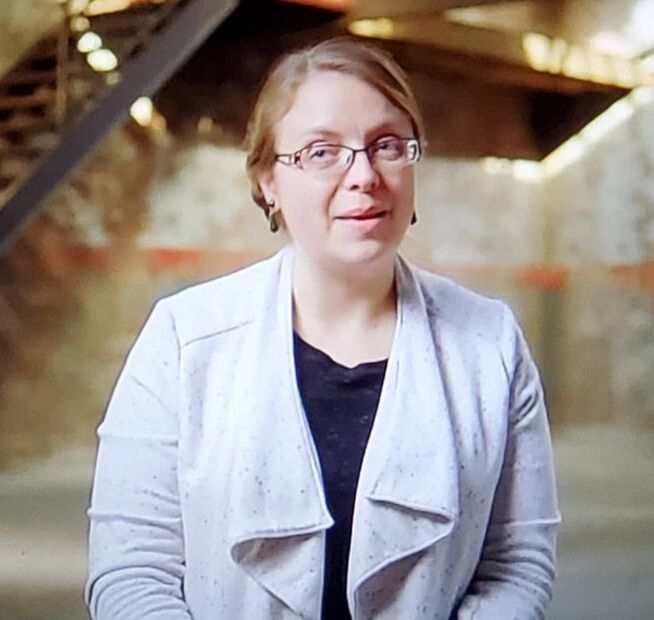 A farmerette in a field near Syracuse, NY in her official uniform of jodhpurs, puttees, and tunic. Note the holes in the knees of her breeches. She appears to be forking clover hay. A farmerette in a field near Syracuse, NY in her official uniform of jodhpurs, puttees, and tunic. Note the holes in the knees of her breeches. She appears to be forking clover hay. One of the best things about being a historian is when the research leads you down new and unexpected paths. In editing and updating my book manuscript, I've been doing research on "farmerettes," also known as the Woman's Land Army of America. Farmerettes were young women, mostly white, middle- and upper-clsas teachers, shop girls, and college girls, who worked to prove the worth and strength of women by providing agricultural labor during the First World War. I hadn't originally planned to include much more than a mention of farmerettes, largely because Elaine Weiss did such a fantastic job chronicling the history of the Woman's Land Army of America with her book The Fruits of Victory. But the funny thing about life, and historical newspaper research, is that sometimes you come across a little tidbit that takes you in a whole other direction. My tidbit was a rumor about an original building used by the WLAA in Marlborough, NY. The building is still standing (for now - the owner may soon be developing the property, but there's a campaign to move it) but when I started researching "farmerette" and "Ulster County" a whole host of articles popped up and I realized something important - although the WLAA was founded in 1917, most of these articles were from 1919 and 1920. So I started doing a little more digging, and stumbled across this: The Farmerette Newsletter appears to be first published in January, 1919 (although numbers two and three are both from January, 1919, I have not been able to track down volume one, number one). The first article reads:
"The Secretary of Labor has approved an agreement which makes the Land Army a Division under the Department. He has said, in taking this step, that it will be well for us to play for greater activity next summer, and emphasizes the importance of training women in agriculture. In this action of the Government, there is not only a very welcome recognition of the work that has been done, but also a definite program. "It is no longer a war program; but our peace program still includes the feeding of the hungry in the Old World. We still have to "help Hoover," and Hoover has pledged to Europe twenty million tons of food in 1919. This will not be possible without more than normal farm labor. Therefore the Government has said that the Land Army is not to demobilize, but is to be directed as a part of the nation's service from Washington." What. The Woman's Land Army of America started out as an all-volunteer copycat of British organizations and was strongly tied to women's suffrage movements. And yet, by 1919, here it was partnering with and possibly even being subsumed by the Department of Labor, a fact that seems unlikely, but appears to be very true. This is what I love so much about food history - in this one primary source we have insight into the history of agriculture, women's suffrage, and the post-war labor shortage. The revelation that the Woman's Land Army of America coordinated with the Department of Labor puts a whole new spin on the movement, and illustrates the impact of the Great War on labor in America. Ultimately, the farmerette movement seems to have died out by the close of 1920, perhaps because agricultural labor was not exactly a lucrative endeavor for young women who expected more from life. At any rate, the later years of the farmerettes are going to join surplus food riots, labor shortages, agricultural advancements, and other post-war events and innovations in their own little chapter in Preserve or Perish.
2 Comments
3/22/2019 08:33:51 pm
Actually, I used to read several articles that are written in The Farmerette Newsletter. All their articles are worthy the read. The newsletter is composed of wide variety of articles, that's why you will surely enjoy reading it especially if you are the type of person who is into reading that much. I am sure that you will never get disappointed once you read an article here! That's just one thing I am sure of!
Reply
Your comment will be posted after it is approved.
Leave a Reply. |
AuthorSarah Wassberg Johnson has an MA in Public History from the University at Albany and studies early 20th century food history. Archives
July 2024
Categories
All
|


 RSS Feed
RSS Feed